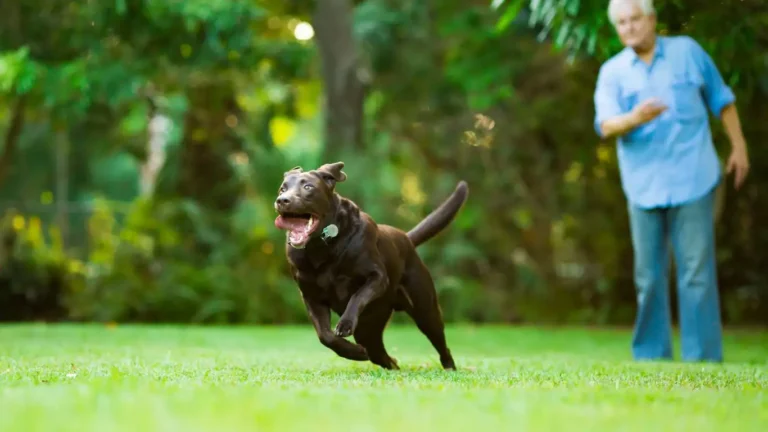Can Dogs Suffer From Depression? Discover Key Signs to Look For
As a pet nutritionist and a pet care expert in a veterinary clinic, I’ve seen it all—happy, energetic dogs, and sadly, some that are down in the dumps. But can dogs suffer from depression? The short answer is yes. Just like humans, dogs can experience mental health issues, including depression. It’s not always easy to spot, though, and many pet owners don’t realize their furry friend may be struggling with emotional distress. Over the years, I’ve observed countless signs that suggest a dog may be dealing with depression, and I’m here to share what I’ve learned.
Can Dogs Suffer From Depression? Understanding the Signs

When people talk about dogs suffering from depression, the concept often gets brushed aside or misunderstood. We tend to think of dogs as joyful, playful creatures who are always ready for a game of fetch or a walk in the park. However, just like us, they can go through periods where they feel down.
But how do you know if your dog is experiencing this? Unlike humans who can express their emotions verbally, dogs rely on their behavior to communicate how they’re feeling. Some of the signs of depression in dogs might be subtle, while others are quite obvious. It’s crucial to pay attention to their body language, habits, and changes in behavior to spot the early signs.
In this article, I’ll walk you through the most common signs that your dog might be struggling with depression and what you can do to help.
1. Withdrawal and Lethargy

One of the first signs I notice in dogs who are dealing with depression is a noticeable change in their energy levels. A dog who used to run around excitedly might suddenly appear uninterested in their favorite activities. Whether it’s playing fetch, going for walks, or simply spending time with the family, a depressed dog may lose interest in these things.
They may also exhibit lethargy, spending more time lying around or in a corner, looking uncharacteristically still. This lack of energy is often a clear sign that something is off with their mental state. Depression can be exhausting, and just like humans, a dog can feel too tired or low to do much, even the things they once loved.
2. Changes in Appetite
Another telltale sign of depression in dogs is a change in eating habits. I’ve seen it many times at the clinic: dogs either lose their appetite entirely or become overly picky with their food. Some dogs may skip meals or eat much less than usual. On the other hand, some dogs may overeat as a way to cope with their emotional state.
If you notice your dog is eating significantly less or more than usual, it’s worth paying attention to any other symptoms that might indicate depression. Keep an eye out for changes in their weight as well, especially if their eating habits fluctuate dramatically.
3. Sleeping More Than Usual
Just like people, dogs need their rest. But if you find your dog is sleeping far more than usual, this could be a sign that they’re not feeling right. Depressed dogs may sleep longer hours, often to escape their feelings of sadness or disconnection.
While it’s normal for dogs to sleep a lot, especially if they’re older or have had a busy day, sleeping excessively without any real physical activity may be a red flag. Make sure to observe if there’s a lack of interaction or playtime despite being home with them. This could indicate a deeper emotional issue.
4. Changes in Behavior Towards Their Owners
Dogs are incredibly social animals and thrive on companionship. When a dog begins to withdraw from their owner or refuses to engage in affection, it can be a clear sign of emotional distress. Depressed dogs may stop seeking out attention or cuddles from their owners, even if they typically enjoy being close to them.
If your usually affectionate dog suddenly becomes standoffish, it could be due to feelings of sadness or discomfort. They may not want to be petted or even refuse to interact with the family altogether. This behavior is often seen when a dog is struggling emotionally but doesn’t have the energy to express what they need.
5. Destructive Behavior
Depressed dogs may turn to destructive behavior as a way of coping with their emotions. I’ve had several clients come in with chewed-up shoes, furniture, and random household items after their dogs started showing signs of depression. This behavior is often a result of boredom, frustration, or anxiety. It’s as if they are trying to distract themselves from their feelings or find an outlet for their restlessness.
If your dog is acting out in ways that are unusual for them—chewing, digging, or even soiling the house—this could be a symptom of emotional distress. It’s essential to address both the behavior and the underlying emotional issue to help them feel better.
6. Excessive Whining or Barking
In some cases, dogs suffering from depression may vocalize more than usual. This could come in the form of whining, barking, or howling. These sounds may be a cry for help or an attempt to express anxiety, loneliness, or frustration. In my experience, this behavior often increases when a dog feels neglected or has had a major change in their routine, such as the loss of a companion or a change in living environment.
If your dog is unusually vocal or seems to be trying to get your attention in an anxious way, it might be time to evaluate their emotional well-being. Pay attention to any triggers that could be causing this behavior and try to create a comforting environment to help them feel secure.
Understanding the Emotional Needs of Your Dog

Understanding that dogs can suffer from depression is the first step toward providing them with the emotional support they need. Just like us, they have emotional ups and downs. However, unlike humans, dogs can’t tell us what’s wrong in words. They communicate through their actions, and it’s up to us to notice the signs and provide the care they need.
In the next section, we’ll dive deeper into how you can help a dog who may be suffering from depression. Stay tuned for more tips on how to create a more positive environment for your furry friend!
How to Help a Depressed Dog: Practical Tips and Solutions

Now that we’ve identified some signs of depression in dogs, you may be wondering: What can I do to help? Fortunately, there are many ways to support a dog who’s struggling with their emotions. Just like us, dogs need love, attention, and a sense of security to thrive. If you suspect that your dog is suffering from depression, here are some steps you can take to improve their well-being and help them feel better.
In my years of working in veterinary clinics, I’ve seen firsthand how simple adjustments in a dog’s environment, routine, and care can make a huge difference. Let’s dive into some of the most effective ways to lift your dog’s spirits and help them recover from emotional distress.
1. Create a Routine and Stick to It
Dogs thrive on routine. They find comfort in predictability, and a consistent daily schedule can help reduce anxiety and give them a sense of stability. If your dog is feeling depressed, try to establish a regular routine that includes feeding, walks, playtime, and rest.
I’ve seen so many dogs start to show signs of improvement just by knowing when to expect things to happen. A dog who’s experiencing depression may feel anxious or unsettled if their daily routine is disrupted, especially if they’re used to certain rituals, like a walk at a specific time or a regular play session. Try your best to stick to these routines, even if it’s tempting to change things up. Consistency is key to creating a secure environment for your furry friend.
2. Increase Physical Activity
Exercise is one of the best ways to help alleviate depression in dogs. Physical activity stimulates the release of endorphins, the “feel-good” hormones that boost mood. In addition to that, exercise gives dogs an opportunity to expend pent-up energy and gives them something positive to focus on.
I always recommend taking depressed dogs for more walks, increasing playtime in the yard, or introducing fun activities like agility training or interactive games. If your dog isn’t up for long walks, try shorter, more frequent sessions. Even a few minutes of play with their favorite toy can make a big difference in how they feel.
Dogs who are physically active are less likely to feel bored or anxious, both of which can contribute to depression. Make sure the activity is appropriate for your dog’s age, breed, and health status. For example, senior dogs or dogs with joint issues may need gentler exercise options like swimming or short walks.
3. Provide Mental Stimulation
Mental stimulation is just as important as physical exercise for dogs. A bored dog is more likely to become frustrated and depressed. To prevent this, make sure your dog has plenty of enrichment activities to engage their mind.
Simple things like puzzle toys, treat-dispensing toys, or hide-and-seek games can keep a dog mentally engaged. You can also try training your dog in new tricks or commands. Positive reinforcement-based training not only stimulates your dog’s mind but also strengthens your bond with them, which is crucial when they’re going through a tough time emotionally.
In my experience, mental stimulation helps redirect a dog’s focus from negative emotions and fosters a sense of accomplishment. If your dog loves sniffing or searching, hide treats around the house for them to find—it’s a great way to provide both mental and physical exercise!
4. Offer Extra Love and Attention
If your dog is feeling depressed, they need your love and attention more than ever. They might not seek out affection on their own, but it’s important to offer it anyway. Gently petting, cuddling, or sitting with your dog can provide them with comfort and reassurance.
Even if your dog seems uninterested at first, continue to offer your presence. Just like us, dogs need reassurance that they’re loved, and their emotional recovery often begins with simply knowing they’re not alone. Spend quality time with them, even if it’s just lying on the couch together or having a quiet moment in the yard.
In addition to affection, try maintaining positive interactions. Avoid scolding or punishing your dog for behavior related to their depression, like being withdrawn or quiet. These behaviors are symptoms of their emotional state, not signs of mischief or disobedience. Patience and empathy will go a long way in helping them heal.
5. Try Natural Supplements
In some cases, natural supplements can help alleviate symptoms of depression in dogs. Some of my clients have had success using calming products like CBD oil, valerian root, or tryptophan-based supplements. These can help regulate your dog’s mood and promote relaxation without the need for prescription medications.
Before trying any supplements, I always recommend consulting with your veterinarian. Not all supplements are suitable for every dog, and it’s important to ensure that the supplement doesn’t interact with any other medications your dog may be taking. Your vet can also guide you on the right dosage and the best products for your dog’s specific needs.
6. Socialization and Interaction with Other Dogs
Sometimes, depression in dogs can stem from loneliness or a lack of social interaction. If your dog is used to spending time with other dogs, consider organizing playdates or dog park visits. A social dog can benefit greatly from the companionship of other dogs, especially if they’re missing a playmate or companion.
However, if your dog is more introverted or nervous around other dogs, don’t push them into social situations that might cause more anxiety. Instead, try engaging with them one-on-one and work on strengthening your bond with calm, positive interactions.
If you think your dog could benefit from the company of another pet, consider adopting a second dog, but keep in mind that this is a significant decision and should be made with careful consideration of your dog’s temperament and the needs of both animals.
When to Consult a Veterinarian

If your dog’s depression symptoms persist or worsen despite your efforts, it may be time to consult a veterinarian. Sometimes, depression in dogs is linked to an underlying medical condition, such as pain, illness, or neurological issues. A thorough checkup can help rule out physical causes for your dog’s behavior changes.
In some cases, your vet may recommend a behavioral therapist or even prescribe medication to help manage your dog’s depression. If your dog’s depression is affecting their daily life or health, professional guidance can be a crucial step in their recovery process. Don’t hesitate to reach out to your veterinarian if you have concerns about your dog’s mental well-being. Your vet is there to support both you and your dog through the healing process.
Final Thoughts
Helping a dog through depression can take time and patience, but it’s so rewarding to see them recover and return to their happy, energetic selves. By providing consistent routines, physical and mental stimulation, extra love and attention, and possibly even natural supplements, you can help your dog navigate through tough emotional times. And if needed, don’t hesitate to reach out to your vet for additional support.
When Depression in Dogs Becomes a Long-Term Issue

While many dogs experience periods of sadness or temporary depression, some may go on to develop longer-term emotional struggles. As a pet nutritionist and someone who’s worked in veterinary clinics, I’ve seen both the quick fixes and the more challenging cases. In some instances, dogs don’t just bounce back after a few extra walks or a bit of affection—they need ongoing support and professional help to manage their depression.
If your dog’s depressive symptoms continue for weeks or months, it’s important to monitor their progress closely. Depression that lasts too long can lead to other behavioral issues or even physical health concerns. In this section, I’ll walk you through the steps to take when you’re dealing with a dog whose depression has become a longer-term concern.
Recognizing Persistent Symptoms
While some dogs may snap out of their depressive state once they’re given a little extra attention, others might persist in their behaviors for longer. The signs of persistent depression are typically more severe and can include:
- Continuous lethargy: Your dog may sleep all day and avoid activities they once enjoyed for weeks or even months.
- Extreme withdrawal: They may refuse to interact with people or other animals, even if they usually love socializing.
- Severe changes in appetite or weight: Eating too much or too little could signal that your dog is emotionally struggling.
- Increased anxiety: Depressed dogs may also develop symptoms of anxiety, such as excessive barking or destructive chewing.
If you notice any of these long-term signs, it’s crucial to take action sooner rather than later. I’ve seen firsthand how long-term depression can impact a dog’s health, causing them to lose weight, develop behavioral issues, or even grow physically ill due to the emotional strain. However, there’s still hope, and with the right steps, you can help your dog work through their depression.
Seeking Professional Help for Long-Term Depression
When a dog’s depression persists despite your best efforts at home, professional intervention may be necessary. This is where the expertise of your veterinarian, a veterinary behaviorist, or a dog trainer specializing in emotional wellness becomes invaluable.
In many cases, a veterinarian will conduct a thorough physical exam to rule out any underlying medical conditions that may be contributing to your dog’s depression. Sometimes, depression can be linked to health issues like pain, thyroid imbalances, or neurological disorders, and these need to be addressed before any emotional treatment can be effective.
If physical health problems are ruled out, your vet may refer you to a veterinary behaviorist or canine therapist who specializes in emotional well-being. They can provide a tailored behavioral modification plan that may include desensitization techniques, counter-conditioning, or even medication to help manage severe depression.
While medications like selective serotonin reuptake inhibitors (SSRIs) or tricyclic antidepressants are often prescribed for dogs with chronic depression, they should always be administered under veterinary supervision. In my experience, medication is most effective when combined with behavioral therapy and environmental changes.
The Role of Diet and Supplements in Long-Term Care
As a pet nutritionist, I can’t stress enough how much of an impact diet can have on a dog’s mental health. Nutritional deficiencies or imbalances can sometimes exacerbate symptoms of depression. For example, a lack of omega-3 fatty acids or certain vitamins can negatively affect brain function and mood regulation.
To support your dog’s mental health, try incorporating foods rich in omega-3 fatty acids, such as fish oil, flaxseed, and salmon, into their diet. These nutrients are known to have anti-inflammatory effects on the brain and can help elevate mood. Additionally, certain supplements like L-theanine, valerian root, or tryptophan may promote relaxation and emotional well-being.
Always consult your veterinarian or a certified pet nutritionist before making any significant dietary changes or adding supplements to your dog’s routine. They can guide you in creating a balanced diet that suits your dog’s specific needs and helps improve their emotional health.
Supporting Your Dog’s Social Needs
Another important aspect of helping a dog with long-term depression is addressing their social needs. While some dogs are perfectly content being solitary, others require more companionship and interaction to maintain their emotional balance.
Consider providing your dog with opportunities for socialization, either through controlled playdates with other dogs or through group training classes. Social interactions can help reduce feelings of isolation and loneliness, both of which can contribute to depression. However, it’s essential to respect your dog’s personality—if they’re more introverted, start slowly and avoid overwhelming them with too much social stimulation.
In some cases, adopting another dog may be beneficial, particularly if your current dog has experienced a loss or is particularly lonely. Introducing a new pet to your home should always be done carefully and with consideration for both animals’ needs and personalities.
Holistic and Alternative Approaches for Managing Depression

In addition to traditional treatments, there are many holistic and alternative approaches that can help a dog manage depression. These methods can complement veterinary care and offer additional ways to support your dog’s emotional well-being.
One popular option is canine massage therapy. Just like humans, dogs can benefit from massage to reduce stress and promote relaxation. Regular massage can help relieve tension in the muscles, reduce anxiety, and improve overall mood. Many pet owners find that canine massage, combined with exercise and affection, can help bring their dog back to a more balanced state.
Aromatherapy is another alternative treatment that’s gaining popularity in the pet world. Certain essential oils, like lavender and chamomile, are known for their calming properties. Diffusing these oils in your home (while ensuring your dog can escape to a different area if needed) may help create a relaxing atmosphere. However, always consult with a professional before using essential oils, as some oils can be toxic to dogs in high concentrations.
Other holistic approaches may include acupuncture or acupressure, which have been shown to help with emotional and physical health. Again, these treatments should always be used in combination with traditional veterinary care and under the supervision of a trained practitioner.
Disclaimer
The information provided in this article is for informational purposes only and should not be considered as veterinary advice. Always consult with a licensed veterinarian or a certified pet professional before making any decisions regarding your dog’s health, including treatment for depression. Every dog is unique, and what works for one may not work for another. Your vet can guide you in the best course of action based on your dog’s specific needs.





